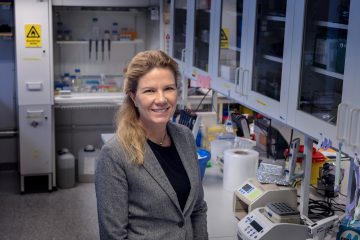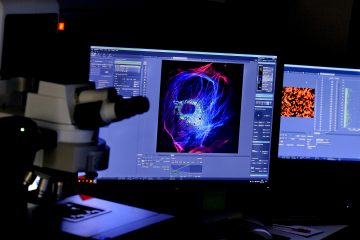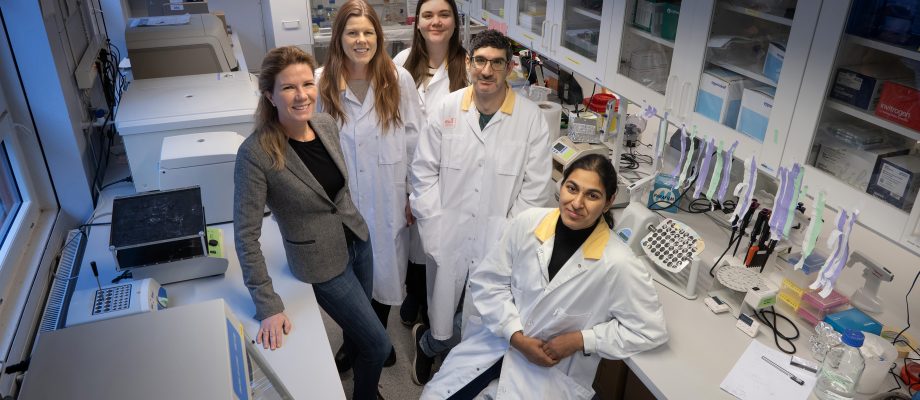RESEARCH ENDEAVOR. In the autumn of 2018, the Lundberg Laboratory for Kidney Research was inaugurated in Gothenburg. The endeavor was made possible by a SEK 27 million grant from the Lundberg Research Foundation. By bringing together both expertise and technical resources, the Lundberg Laboratory for Kidney Research can now contribute to new knowledge about the causes of kidney disease and facilitate the development of new medications.

Kidney disease affects approximately ten percent of the population, both in Sweden and globally. Despite being a prevalent condition, there is considerably less research conducted on kidney disease compared to conditions such as cancer, and there is still a lack of understanding regarding the causes of various types of kidney diseases. Moreover, specific treatments are lacking.
Alongside cancer and orthopedics, kidney disease is a research area prioritized by the Lundberg Research Foundation. The significant need for fundamental knowledge in this field contributed to the foundation’s decision to grant 27 million kronor – the largest donation in the foundation’s history – towards establishing a kidney laboratory in Gothenburg. The project aimed to consolidate kidney research in western Sweden and establish a high-quality laboratory. The Kidney Research Laboratory was inaugurated in the autumn of 2018 and is now a resourceful center of expertise that attracts national and international collaborators.
“It’s turned out very well, and we feel that we are part of the global advancements in the field of kidney medicine,” says Professor Jenny Nyström, the laboratory’s director since its inception.
Advanced Equipment
Several common kidney diseases affect the nephrons of the kidney, the microscopic units where blood is filtered and urine is formed. To study the intricacies of these units at the molecular and cellular levels, powerful and advanced microscopes are required. Additionally, a range of peripheral equipment is necessary.

“Receiving such a large donation and being able to establish such a well-equipped research laboratory covering the entire spectrum from molecules to patient samples is unique and has meant a great deal. Not only for us. The laboratory’s resources are also used by many other researchers, both in kidney research and other fields. We want the equipment to be as beneficial as possible,” says Jenny Nyström.
Interconnected microscopes
The kidney laboratory’s microscopy room houses three advanced microscopes:
– A scanner microscope, which allows for the analysis of vast amounts of material, enabling researchers to view the entirety while zooming in on details.
– A live-cell microscope, in which researchers can observe living cells and track changes over time.
– A confocal microscope with extremely high resolution, used to study the smallest details such as the location of different molecules within a cell.
Additionally, there is software that connects the microscopes.
“For example, if I find something exciting in the scanner microscope and transfer the material to the confocal microscope to delve deeper into the details, the microscope knows what image I’m after. We also have high-quality analysis software that allows us to extract even more from our data. Having high-quality microscopes is significant. Moreover, their interconnectedness makes a big difference in what we can achieve,” says Kerstin Ebefors, a research colleague of Jenny Nyström.

A long-term commitment
To fully utilize all the functions of the advanced technology, extensive experience is required.
“This fine equipment requires personnel who stay for many years; one needs to become somewhat of a specialist on the machines to extract the best from the analyses,” emphasizes Kerstin Ebefors.
At the laboratory, there is a core of around ten individuals who work with the equipment on a daily basis. In addition to conducting their research, they assist other researchers in maximizing the laboratory’s resources. The combined expertise and technology are unique and have opened doors to many exciting collaborations, both locally, nationally, and internationally.
Collaborations key to success
Jenny Nyström highlights the collaboration with clinical researchers at Sahlgrenska University Hospital:
“Our close collaboration is absolutely a factor in our success. Much of our research is based on samples from patients with kidney disease treated at the hospital, making our research even more relevant and interesting. Additionally, it provides our clinical collaboration doctoral students the opportunity to work with preclinical models and microscopy at our lab.”
Another crucial local collaborator is the pharmaceutical company AstraZeneca. Jenny Nyström and her research group collaborate with them on various basic research projects that may lead to future therapies in the long term. They also have collaboration in the form of a postdoc who works both at the kidney research laboratory and at AstraZeneca. Furthermore, researchers at the Gothenburg laboratory collaborate with colleagues in Stockholm, Germany, and the USA.
Cell communication

Jenny Nyström and her research group primarily study two variants of kidney disease. One is diabetic kidney disease, which affects 30–40 percent of those who have had diabetes for a long time, and the other is IgA nephropathy, the most common inflammatory kidney disease. In both cases, mesangial cells play a crucial role. While other researchers have mapped out the functioning of the different types of cells in the kidney’s filtration units individually, Jenny Nyström’s research group focuses on the exchange of information between the different cell types.
“Cells are constantly communicating with each other, a phenomenon known as ‘cross-talk,’ and influencing each other’s functions. We believe this plays a role in how kidney diseases develop. Both diabetic kidney disease and IgA nephropathy affect the kidney’s filtration units, albeit in different ways, and we have long been studying the properties of these filtration units and how they are affected by various disease states,” she says.
Databases for global benefit
The research group also studies proteins, RNA, metabolomics, and several other expressions in patient samples. Metabolomics determines how well someone’s metabolism can adapt to different conditions. These are extensive analyses that require specialized expertise in bioinformatics.
“We collect data that we and other researchers can use to identify various mechanisms that may play a role in the development of kidney diseases. We can also integrate our data with others’ databases to increase volume or use others’ databases to verify our data. In this way, we contribute to the global level of knowledge,” says Jenny Nyström.
Belief in positive development
“It’s all about elucidating the mechanisms behind the development of these diseases. Since there is still a lot of knowledge missing about how and why these diseases develop, there are also no specific curative medications,” emphasizes Kerstin Ebefors.
At the same time, both researchers are clear that there is currently a very positive development in nephrology, and new medications are hopefully on the way:
“We’re in an exciting time in this research area; things are starting to happen that create energy and make research more interesting for more people. It increases competition, which is good and leads to more research focused on trying to cure kidney diseases. With our laboratory, we are well equipped to contribute.”
BY: THE LUNDBERG FOUNDATION












Leave a Comment